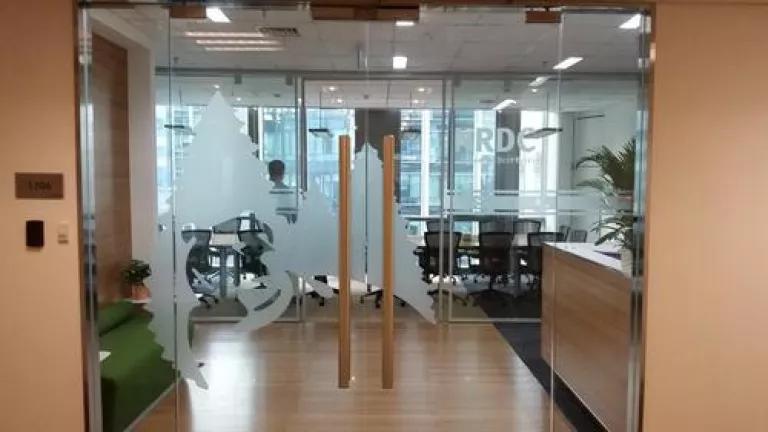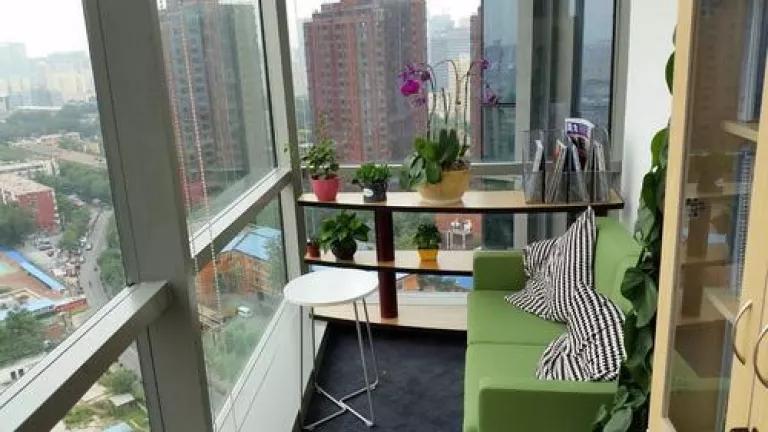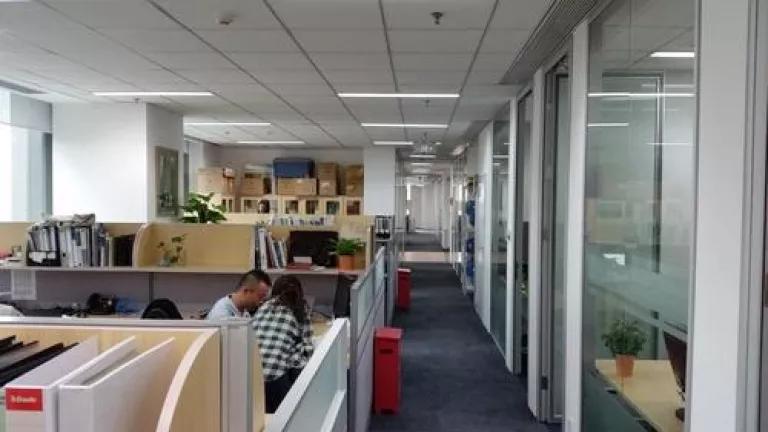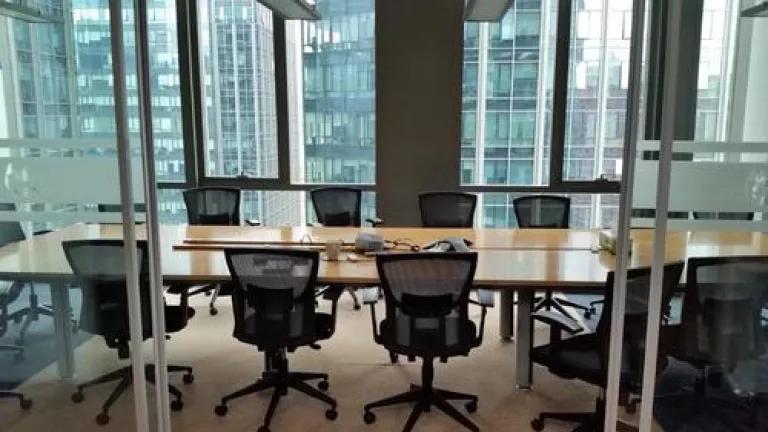
LEED certification from the U.S. Green Building Council is considered the green building industry standard. More than 75,000 projects, from houses and schools to office space and data centers, have been built to LEED standards, saving energy, money and water while promoting the health of occupants. But green buildings don't always manage to avoid toxic chemicals in building materials. A typical wood composite door, for instance, has formaldehyde, a carcinogen, in it. Carpet tiles use PVC, which is made with toxic vinyl chloride, in the backing. Some lighting fixtures contain mercury, a neurotoxin.
NRDC's new office space in Beijing earned Petal Certification from the Living Building Challenge (photo: courtesy Eileen Quigley, Closed Loop Advisors)
NRDC has been a leader in LEED-certified offices, but we wondered if we could build even greener. So we set ourselves a new challenge: to not only meet LEED criteria, as we have with all our offices, but to take extra steps to eliminate dangerous chemicals from all the construction materials inside our new office spaces, right down to the gaskets and sheetrock. I'm proud to say that yesterday, as a result of these efforts, NRDC's Beijing office earned Petal Certification from the Living Building Challenge--the first LBC-certified project in China. And my colleague Anthony Guerrero, who oversees all our office operations worldwide, was named a Living Building Challenge Hero by the International Living Future Institute, which designs the program.
As in all our offices, we set out to build green in Beijing from the start. Location was important--we chose office space in a tower in the Central Business District with easy subway access, including a subway to the airport, ensuring that staff and visitors could reach us without needing a car.

On a clear day, the views are spectacular. (photo: courtesy Eileen Quigley, Closed Loop Advisors)
We re-used most of our existing furniture, even including some light fixtures. And the office was designed with an open floor plan to give everyone access to daylight (on a clear day, the view is spectacular), and to create the collaborative atmosphere that's so important to our work. By bringing in more natural light, the design also saves money and energy by reducing the need for lighting.

Open floor plans allow more natural light, and more collaboration. (photo: courtesy Eileen Quigley, Closed Loop Advisors)
Outdoor air pollution is a severe problem in many parts of China these days, so we wanted to make sure the air inside the office was as healthy as possible for our Beijing colleagues. Still, avoiding toxic chemicals that might pollute the indoor air--14 of them are on the Living Building Challenge Red List--wasn't easy. They don't call it a "challenge" for nothing.
Even major manufacturers, including Sherwin Williams and Philips Lighting, consider their ingredients proprietary and refuse to disclose what chemicals are used in their products. Oftentimes, the manufacturers aren't aware of the full process behind their products--like how is that laminate glued to the wood base of the desk? And is the laminate made from FSC-certified wood?

Finding furniture, flooring and carpet tiles free of toxic chemicals was a challenge. (photo: courtesy Eileen Quigley, Closed Loop Advisors)
Anthony and his team started asking questions like these--a process that began with our Midwest office in Chicago, which earned Petal Certification last year. Sometimes they couldn't get an answer. Sometimes it was the wrong answer. But other times, as suppliers started to probe more deeply into their supply chains, they found they could make changes. And they did. When Anthony found a neoprene gasket in an energy and water-monitoring device, our supplier was able to substitute a non-toxic version. Now, the non-toxic replacement gasket has become their standard.
Bamboo, a local, natural product with enormous cultural significance in China, seemed like an obvious choice for our Beijing office--but bamboo products often use toxic formaldehyde as a binder. Our team searched and finally found a local bamboo flooring supplier who used a soy-based binder instead of formaldehyde.
Many of the manufacturers we worked with, both in Beijing and in Chicago, have since joined Declare, an ingredients label for the building industry. Like nutrition labels for food, Declare labels make building materials more transparent. Ten products in China have now been registered in the Declare program--before our project, there were none. Slowly, we're helping push the construction industry to abandon toxic ingredients and switch to cleaner building materials.
We've not only created a terrific workspace for our staff in China, but are incorporating these more rigorous, healthier standards into everything we do. In Washington, D.C., an old kitchen countertop isn't just being reordered with the click of a button. Anthony and his team, armed with the Red List, are out there working with suppliers to find a countertop made without toxic chemicals, start to finish. Same thing with our window shades in Santa Monica. And upcoming renovations in our San Francisco and Chicago offices will be pursuing the updated Living Building Challenge 3.0 criteria, which covers even more materials.
Of course, NRDC's green building work isn't limited just to our own offices. While we use our own work spaces to try to illustrate what's possible, NRDC is also developing solutions that can spark widespread change in how buildings work. My colleagues on NRDC's new Urban Solutions team are helping cities find cost-effective ways to improve energy efficiency in office buildings, which are the largest source of global warming pollution in cities, as well as in affordable housing, an untapped source of energy efficiency.
We're working toward a future in which healthy, efficient buildings are the rule, rather than the exception. What if buildings actually made a positive contribution to the environment, instead of sucking up energy and water and churning out carbon pollution? It's a tantalizing future to imagine--and one that becomes more real, thanks to heroes like Anthony, and thanks to my colleagues on our Urban Solutions team--every day.
